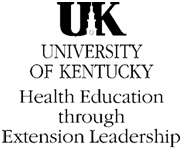The National Institute of Health in a fact sheet on health disparities frames the issue in this way: "Americans enjoyed improved health and longer lives during the latter part of the 20th century. However, African Americans, Hispanics, Native Americans, and Asian/Pacific Islanders, who represented 25 percent of the U.S. population, continued to experience striking health disparities, including shorter life expectancy and higher rates of diabetes, cancer, heart disease, stroke, substance abuse, and infant mortality and low birth weight. Scientists believed these health disparities resulted from the complex interaction among several factors such as biology, the environment, and specific behaviours that were significantly impacted by a shortage of racial and ethnic minority health professionals, discrimination, and inequities in income, education, and access to health care."
In Kentucky, Appalachia also is impacted by high poverty levels, a shortage of health professionals, inequities in education and access to health care. HEEL was funded to address the rural health disparities in health literacy. One such project is Team UP! which successfully leveraged a state and local partnership to improve screening rates of never or rarely screened women in 9 east Kentucky counties. This project is being presented at a poster session at the NIH Summit on the Science of Health Disparities this week in National Harbor, MD.
Tuesday, December 16, 2008
Thursday, December 4, 2008
KY Children not as Healthy as they could be : A Snapshot of Kentucky
The Robert Wood Johnson Foundation has published a report ranking the states on surrounding social, economic and physical environment factors that affect our health. According to RWJ "the levels of health for most Kentucky children fall short of levels for children in the most advantaged subgroups in the state and across the country."
The reports states:
"Kentucky ranks 30th among states based on the size of the gap in infant mortality by mother’s education, when comparing the current overall state rate of 6.2 deaths per 1,000 live births with the lower rate—3.9 deaths per 1,000 live births—seen among infants born to the state’s most educated mothers.
Kentucky ranks 29th among states based on the size of the gap in children’s general health status by family income, when comparing the current overall rate of 13.1 percent of children in less than optimal health with the lower rate—5.3 percent—seen among children in higher-income families."
See the complete report at RWJF website.
The reports states:
"Kentucky ranks 30th among states based on the size of the gap in infant mortality by mother’s education, when comparing the current overall state rate of 6.2 deaths per 1,000 live births with the lower rate—3.9 deaths per 1,000 live births—seen among infants born to the state’s most educated mothers.
Kentucky ranks 29th among states based on the size of the gap in children’s general health status by family income, when comparing the current overall rate of 13.1 percent of children in less than optimal health with the lower rate—5.3 percent—seen among children in higher-income families."
See the complete report at RWJF website.
Subscribe to:
Posts (Atom)
